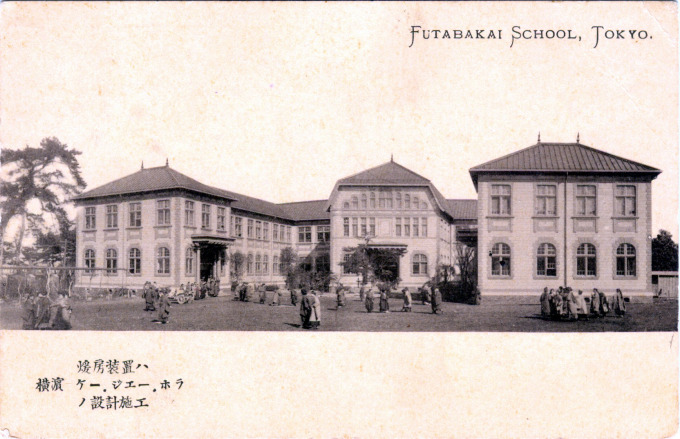
Futaba-kai School, Tokyo, c. 1910, after the relocation and completion in 1910 of its new campus near the Imperial Palace at Kojimachi in Tokyo. Founded in the 1870s by the Sisters of St. Maur, the name Futaba-kai translates to the education-apropos ‘organization of growing sprouts’. Futaba School has become famous for providing the primary school education of Japan’s two most recent empress-wives, Michiko (1989-2019) and Masako (2019-present).
See also:
Girls Normal School, Ochanozmizu, c. 1910.
The Peers’ School, Tokyo, c. 1910.
The 1st Higher School, Tokyo, c. 1910.
“The Sisters of St. Maur, who went to Japan in the 1870s, remain active there today … They continue to run respected schools in Japan, such as the Futaba [trans. of St. Maur] school in the Kojimachi area of Tokyo, where the current empress studied for three years, amd the Futaba Denenchofu school, where Masako, the wife of the crown prince, was educated.
“… When Mother Saint Therese was teaching at Futaba school in Tokyo, she often said to her students, ‘I did not come to Japan to spread French culture, nor to recruit lightly a number of new Christians. I came to help you become what you want to be: serious-minded, refined, real Japanese women.'”
– Xavier’s Legacies: Catholicism in Modern Japanese Culture, edited by Kevin M. Doak, 2011
There are four sister Futaba schools in Japan: Denen-chofu (Tokyo), Yokohama, Shizuoka, and Fukuoka. There are also sister schools overseas as well, such as Singapore and Malaysia, and the activities of the schools extend to 16 countries in the world, including Europe, Southeast Asia, South America, and Africa.


Pingback: The Peers' School, Tokyo, c. 1910. | Old Tokyo
Pingback: Kochi Jogakkai [Kochi Girls' School], Kochi, c. 1920. | Old Tokyo
Pingback: Duncan Academy, Tokyo, c. 1910. | Old TokyoOld Tokyo
Pingback: Imperial Wedding, 1959. | Old TokyoOld Tokyo